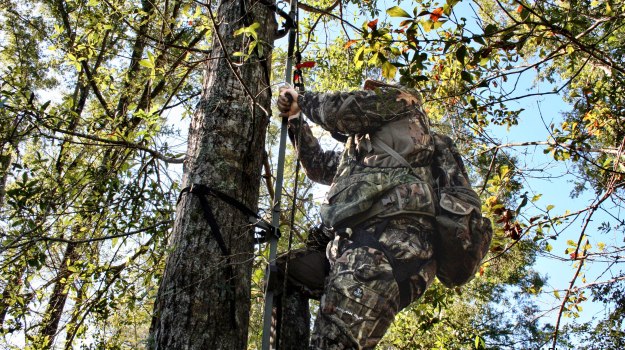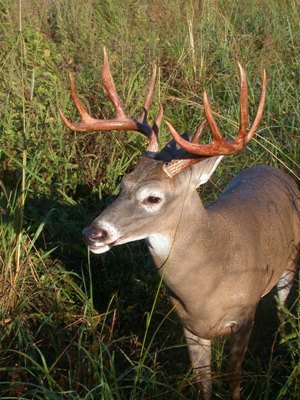
Editor’s Note: Mossy Oak Pro Lance Howard lives in Theodore, Alabama, just south of Mobile, in one of the southernmost sections of Alabama. During the Great Depression of the 1930s, when deer and turkey were nearly wiped out across Alabama, large landowners in south Alabama protected the deer and turkeys on their lands. Today these many south Alabama deer have resulted in overpopulation of the deer herd there. Howard has lived on his family’s 3,500 acre peanut and cotton farm all his life and has developed strategies for taking deer there.
By hunting the second bedding area, I see most of the deer that I hunt between 8 and 9 a.m., going from their early morning bed to their all-day bed, depending on the moon phase and the weather. After scouting my property, I've learned that the first bedding area is usually within 100 yards of the peanut field, but the primary bedding area often will be from 1/4-mile to 1,000-yards away from the peanut fields where they feed. The first bedding places close to the peanut field are usually in high grass. We have a problem with an invasive species of grass called cogongrass (it’s been in the U.S. since 1912 and is found primarily in the Deep South) that’s usually 2 - 3 feet tall and crowds out native species. When deer leave the cogongrass, they move into young pine plantations or gallberry thickets that have higher and thicker cover.
I've discovered that the real key to taking deer all year long on the land I hunt is: first of all don’t let the deer know that I'm hunting them. I want to be the least intrusive I can be to not spook the deer or disturb the place I'm hunting. I think one of the reasons that early-season bowhunters aren’t as successful as they can be is because when they go to their stands, they spook the deer they're trying to take. By going to my stand when I have plenty of daylight, I can walk more quietly through the woods, and I know I'm a good distance away from the deer I'm hoping to take, since they're bedded down close to the peanut fields. I'll set up between their first bedding area and their second bedding area.
I try to get in a stand when the deer are least likely to see, smell or hear me. I don’t set up as close as I can to the trail the deer will come down to get a close bow shot. I'm really confident at taking a shot in the woods from 40 to 45 yards. I think this mistake of getting too close to where they expect the deer to be is one early bowhunters often make. Then, they spook those deer when they stand to take shots, when they draw their bows back, with any movement they may make, or if the wind changes, and the deer smells them. When I'm hunting later in the season on a food plot or a green field where the deer are relaxed and not looking for danger, I feel confident taking a bow shot at 50 to 55 yards. These are my hunting tactics for hunting in early season when agriculture is the primary food source for the deer in our area.
 After the agriculture is harvested, then the deer start showing up on our food plots. Because I hunt a working farm, and we try to utilize as much land as we can to produce crops, there’s not much natural green vegetation left after the crops are harvested. So, we plant food plots. We use Mossy Oak BioLogic Green Patch Plus and Mossy Oak BioLogic Maximum. In most areas farther north,Green Patch Plus is pretty much done when cold weather arrives. But here in south Alabama where we have very little, if any, cold weather, BioLogic Green Patch Plus will produce deer food usually into February. Because we have some small food plots that are only about 1-1/2- to 3 or 4 acres, we usually mix in Mossy Oak BioLogic Maximum with the Green Patch Plus. Because we have so many deer, as I see the deer beginning to eat the entire Green Patch Plus, I’ll come back over that same food plot and top sow Mossy Oak BioLogic Maximum. Maximum is made up of many small seeds. The deer that are coming to that food plot will step on the seeds and crush them into the ground. When we get a rain, the rain will loosen the soil and beat the seed into the ground. In the late season, if we don’t sow Maximum over our Green Patch Plus plantings, the deer will eat the Green Patch Plus all the way down to the ground and kill it. But by top-sowing Maximum, we now have another crop too. The Maximum helps protect our Green Patch Plus planting by producing more green food for the deer to eat. The Maximum produces more tonnage of food and lasts longer through the winter months than the Green Patch Plus.
After the agriculture is harvested, then the deer start showing up on our food plots. Because I hunt a working farm, and we try to utilize as much land as we can to produce crops, there’s not much natural green vegetation left after the crops are harvested. So, we plant food plots. We use Mossy Oak BioLogic Green Patch Plus and Mossy Oak BioLogic Maximum. In most areas farther north,Green Patch Plus is pretty much done when cold weather arrives. But here in south Alabama where we have very little, if any, cold weather, BioLogic Green Patch Plus will produce deer food usually into February. Because we have some small food plots that are only about 1-1/2- to 3 or 4 acres, we usually mix in Mossy Oak BioLogic Maximum with the Green Patch Plus. Because we have so many deer, as I see the deer beginning to eat the entire Green Patch Plus, I’ll come back over that same food plot and top sow Mossy Oak BioLogic Maximum. Maximum is made up of many small seeds. The deer that are coming to that food plot will step on the seeds and crush them into the ground. When we get a rain, the rain will loosen the soil and beat the seed into the ground. In the late season, if we don’t sow Maximum over our Green Patch Plus plantings, the deer will eat the Green Patch Plus all the way down to the ground and kill it. But by top-sowing Maximum, we now have another crop too. The Maximum helps protect our Green Patch Plus planting by producing more green food for the deer to eat. The Maximum produces more tonnage of food and lasts longer through the winter months than the Green Patch Plus.
In the bigger plots, we only may plant Green Patch Plus. Because cotton and soybean farming both draw so many nutrients out of the soil, once those crops are harvested, the farmer comes back immediately, plows the field and plants a cover crop of wheat and oats. These crops tend to put nutrients back in the ground throughout the fall and winter. As these crops are sprouting and coming up, we’ll have 100-acre fields planted in wheat and oats.
I don’t start hunting those Green Patch Plus food plots until late December or early January. I generally hunt the small plots early in the morning. I've learned that just prior to the rut, during the rut and just after the rut, the bucks will be out in the 100-acre fields chasing does. But early in the morning, when a buck's coming out of the big wheat and oat fields, he usually will come by and look for does that may be feeding on my BioLogic Green Patch Plus fields. The does will start hitting those Green Patch Plus food plots early in the morning. Of course, the bucks are looking for the does.
To learn more about hunting, check out John E. Phillips’ new eBook and print book, “Bowhunting Deer: Mossy Oak Pros Know Bucks and Bows.” You also can download a free Kindle app that enables you to read the book on your iPad, computer or Smartphone.
For information on making jerky from your deer to provide a protein-rich snack, you can download a free book from http://johninthewild.com/free-books.
Day 1: Hunt Bucks Between Two Bedding Areas in the Mornings
Tomorrow: Harvest a Doe Every Day and Three Bucks Per Season



























